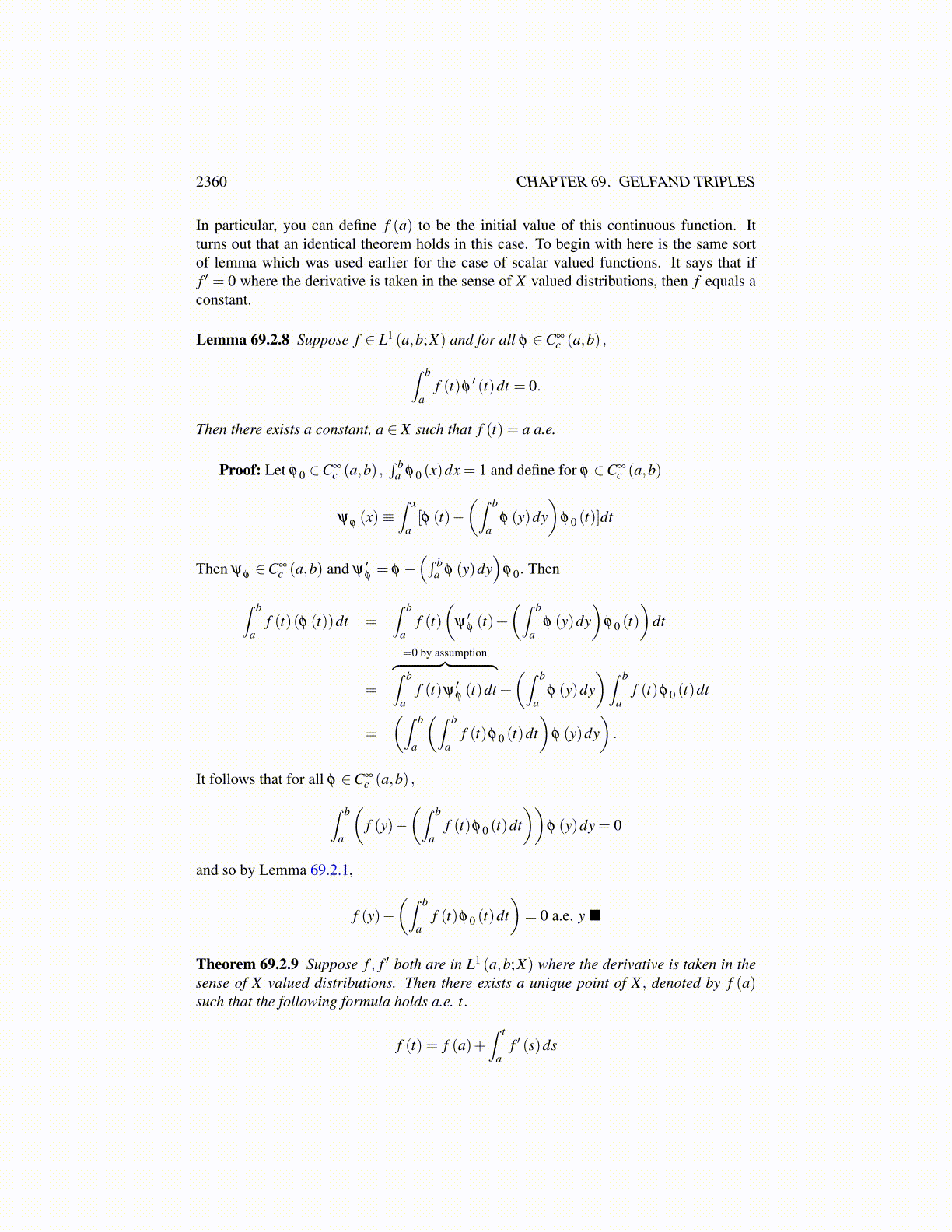
2360 CHAPTER 69. GELFAND TRIPLES
and the integrand of the last integral converges to 0 a.e. as n→∞ because ∑n m(Vn \Kn)<∞. By the dominated convergence theorem, this last integral converges to 0. Therefore,whenever E ⊆ (a,b) , ∫ b
aXE (t)g(t)dt = 0.
Since the endpoints have measure zero, it also follows that for any measurable E, the aboveequation holds.
Now g ∈ L1 ([a,b] ;X) and so it is measurable. Therefore, g([a,b]) is separable. LetD be a countable dense subset and let E denote the set of linear combinations of the form∑i aidi where ai is a rational point of F and di ∈ D. Thus E is countable. Denote by Y theclosure of E in X . Thus Y is a separable closed subspace of X which contains all the valuesof g.
Now let Sn ≡ g−1 (B(yn, ||yn||/2)) where E = {yn}∞
n=1 . Thus, ∪nSn = g−1 (X \{0}) .This follows because if x ∈ Y and x ̸= 0, then in B
(x, ||x||4
)there is a point of E,yn. There-
fore, ||yn||> 34 ||x|| and so ||yn||
2 > 3||x||8 > ||x||
4 so x ∈ B(yn, ||yn||/2) . It follows that if eachSn has measure zero, then g(t) = 0 for a.e. t. Suppose then that for some n, the set, Sn haspositive measure. Then from what was shown above,
||yn|| =
∣∣∣∣∣∣∣∣ 1m(Sn)
∫Sn
g(t)dt− yn
∣∣∣∣∣∣∣∣= ∣∣∣∣∣∣∣∣ 1m(Sn)
∫Sn
g(t)− yndt∣∣∣∣∣∣∣∣
≤ 1m(Sn)
∫Sn
||g(t)− yn||dt ≤ 1m(Sn)
∫Sn
||yn||/2dt = ||yn||/2
and so yn = 0 which implies Sn = /0, a contradiction to m(Sn)> 0. This contradiction showseach Sn has measure zero and so as just explained, g(t) = 0 a.e.
Definition 69.2.2 For f ∈ L1 (a,b;X) , define an extension, f defined on
[2a−b,2b−a] = [a− (b−a) ,b+(b−a)]
as follows.
f (t)≡
f (t) if t ∈ [a,b]f (2a− t) if t ∈ [2a−b,a]f (2b− t) if t ∈ [b,2b−a]
Definition 69.2.3 Also if f ∈ Lp (a,b;X) and h > 0, define for t ∈ [a,b] , fh (t) ≡ f (t−h)for all h < b−a. Thus the map f → fh is continuous and linear on Lp (a,b;X) . It is con-tinuous because∫ b
a|| fh (t)||p dt =
∫ a+h
a|| f (2a− t +h)||p dt +
∫ b−h
a|| f (t)||p dt
=∫ a+h
a|| f (t)||p dt +
∫ b−h
a|| f (t)||p dt ≤ 2 || f ||pp .
The following lemma is on continuity of translation in Lp (a,b;X) .